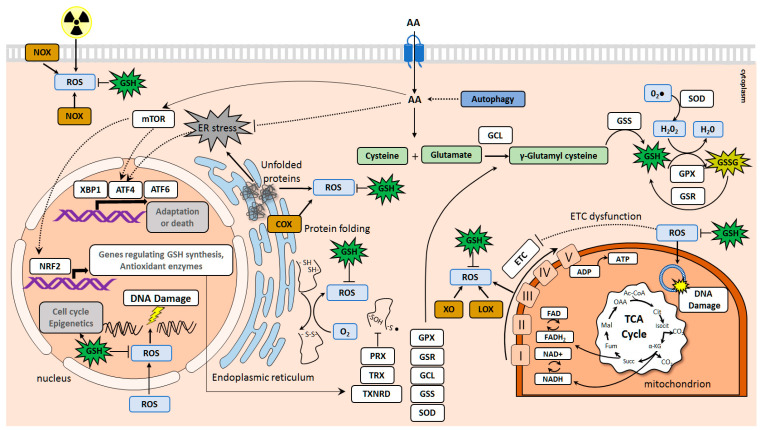Figure 1.
Amino acid transporters in the maintenance of redox homeostasis. The reactive oxygen species (ROS) are generated in the cells in different ways, including the electron transport chain (ETC) in mitochondria, oxidative protein folding in the endoplasmic reticulum (ER), and enzymatic reactions involving, e.g., cyclooxygenases (COX), lipoxygenases (LOX), xanthine oxidases (XO), and nicotinamide adenine dinucleotide phosphate (NADPH) oxidases (NOX). An increased ROS production contributes to the damaging of DNA, lipids, and proteins. Amino acid transporters regulate the redox homeostasis by driving glutathione (GSH) synthesis, inducing mammalian target of rapamycin (mTOR)-mediated antioxidant defense, and preventing endoplasmic reticulum (ER) stress. Autophagy also contributes to the maintenance of the intracellular free amino acid pool. GSH is synthesized in cytosol from Cys and Glu by glutamate-cysteine ligase (GCL) and glutathione synthetase (GSS). The reduced form of glutathione, GSH, is oxidized to glutathione disulfide (GSSG) by glutathione peroxidase (GPX) to neutralize hydrogen peroxide (H202) and is reduced back to GSH by glutathione reductase (GSR). The mTOR mechanism of antioxidant defense includes activation of the nuclear factor-erythroid 2 -related factor 2 (NRF2), a master transcription factor. NRF2 regulates the expression of many genes involved in the GSH synthesis, including GCL, GSS, GPX, GSR, other genes involved in the regulation of ROS levels, such as superoxide dismutase (SOD) enzyme which converts superoxide (O2•−) to H202, genes encoding thiol-specific antioxidant proteins thioredoxin (TRX) and thioredoxin reductase (TXNRD) as well as peroxiredoxin (PRX). mTOR also triggers ATF4-mediated gene expression of the heterodimeric transmembrane amino acid transporters such as SLC7A5 (LAT1), SLC3A2 (CD98hc), and SLC7A11 (xCT).

